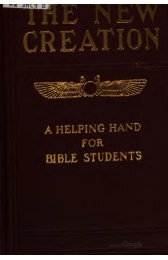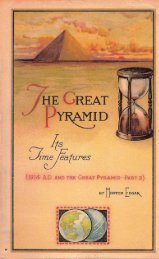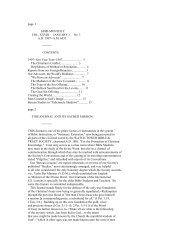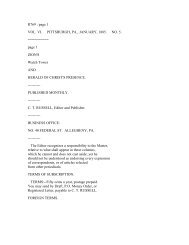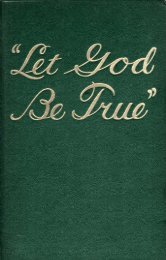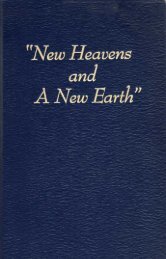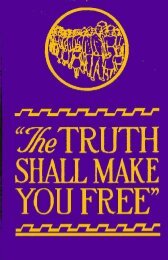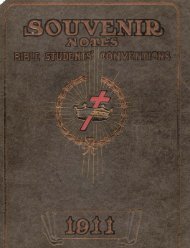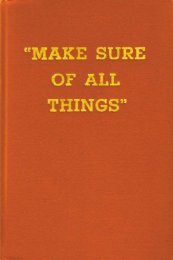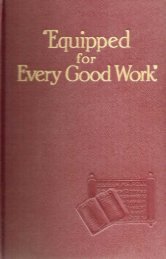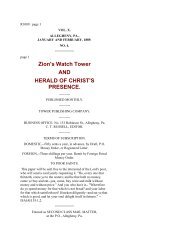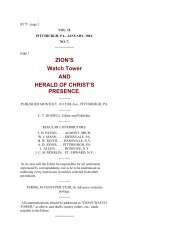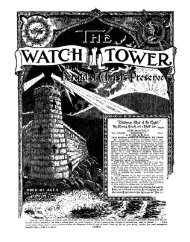The Watchtower Society and John and Morton Edgar - A2Z.org
The Watchtower Society and John and Morton Edgar - A2Z.org
The Watchtower Society and John and Morton Edgar - A2Z.org
- No tags were found...
You also want an ePaper? Increase the reach of your titles
YUMPU automatically turns print PDFs into web optimized ePapers that Google loves.
vIht Golden Age for May 25, 1921nominal adhenntr of Christianitp (so-called),'that the eamo festive-clay was adopted by the- L apostate church, giving it only the name oft. Chrin t.<strong>The</strong> Christmau-tree, so comoii at 111. .. \.. j-,. WM equally common in Pagan Rome <strong>and</strong> Egypt.IIIQThir is the reason why 'qabylon the Great"adopted it; for there ia no corrmirrnd in theSoriptiires reqniring the followers of Christ toobserve the day of his birth by Chlistnias-daycelebrations. Briefly-the putting of the 'Tnle-log" into the fire on Christmas eve? <strong>and</strong> tlieappearance next morning of the Christmas-treeladen with gifts, represented the cousurning ofthe great god who, like the log,hacl been cut illpieces, <strong>and</strong> his after-birth in newness of lifeaa the "Branch of God", or the Tree that bringsgifts to men. <strong>The</strong> Egyptians used the palm fortheir Christmas-tree; but the people of PaganRome used the fir, because the fir-tree covertly7"bolized the risen god as the Baal-berith ofo d Babylon: for Baal-berith, "Lord of theCovenant," differs only one letter from Baalbereth,"l,ord of the Fir-tree".- l'lre God Saturn, <strong>and</strong> Btrll TVorship<strong>The</strong> mystical symbol of Osiris was the young'Ar.3 bull or calf, ripis being another name forSaturn, the hidden one. <strong>The</strong> apis bull was alsoknown as Hap, which in the Egyptian languagemeansWto concealJy. In the Clinldenn languageHap means "to cover''. (Guide to the Eggptia~rCollection in the British Jluseztm, p. 131) Fcnow see why the Jewish nation made <strong>and</strong> \\-orahipedthe image of a calf soon after leavingEgypt under Mos(:s, claiming that this \\-as thegod who had delivered them out of bondage,meaning, of course, that Osiris. wliom the calfrepresented, was the god.<strong>The</strong> bull pas the espress synbol of Ximrod,beihg tlie liieroglyphic which slio\i-ed him asthe "migi:ty one" nnd 'lord of tlie chase". Inmy thology as having "rebelled against heaven".<strong>The</strong> Hebrew word for "mighty oneJ' in Genesis10 : 8 is "gheher". (This same vord in translated"giant' in Job 16: 14) A synonym for glieberis "abir"; but "aber," pronounced nearly thesame as abir, is the word for "~1-ii1g". Thus,"Baal-abirinJy means 'lord of the mighty ones";while "ad-aberinJ' means "lord of the wings",or "winged one". (<strong>The</strong> worcl trbir occurs inJuclges 5: 22-"the praneiligs of their mightyowes"; while nber is fount1 iri Isaiah 40: 31,-"<strong>The</strong>y shall mount up wit11 lcitrgs as eaglesJJ)<strong>The</strong>re is allnsion to the "n-i~tc*" nf an .\ssyrianking in Isnial~ S: 6-3.,4s the honl is the ancic~rt >\-liibol of power,these Assyrian bulls, thougli limiian-headed,~ievertheless ,show horris cul.\-ed around theirheadgear. <strong>The</strong> reason why tlic 11or1i is used asa symbol of lringly authority <strong>and</strong> power appears,from certain sculptures discorered by Layardwhen excavating Babylon, to be clirectly owing-to Nimrocl's prowess as a great Iidilter. In awoodcut in his Nineveh <strong>and</strong> B*!byloih, page GO&Layard shows the Assyrian Hercules (that is,"Nimrod the Gianf', as he is called in the Septuagint,or Greek version of Genesis) ~vithoutweapons attacking a bull. Having coliriaeredthe bull, he sets its horns on his heacl as a trophyof victory, an evidence of his great paver inbeing able to overcome so stsong an ariini:ll.Thus crowned he is now represented as encounteringa lion, the king of beasts. This accountsfor the ancient custoill among Easternnations of kings <strong>and</strong> chiefs wearing liorns ontheir heads as evidence of their power an11authority. - Smith's Bible Dictiojtnr!y, -1rt."HornJ'.A variant of the great hunia~i-heaclecl ~vir~r(.tlflgures found in 9ssyria has the body of a lion,instead of the body of the hull. <strong>The</strong>se are ca!ledby Aseyriologists "clierubs"; because the fourcherubs described by Ezekiel are, in a sense, incorporatedin each of these sculptures, i~ail~clv,Assy ria tile worcl ro r.-l>ull"signifies also "ruler"or "prilrcc": a~icl it \;.as for this season that the the lion's body, tlie eagle's ~vings, the face of a-mighty kings of E:i!q-lonia rrrlcl -4ssyria. u.ho man, <strong>and</strong> the bdl's or calf's I~orns. (See Ez.~l;ielsnccecclcd n~id iiiiitatc~l Simrod, the first king, 1 : 4-10, <strong>and</strong> cornpare I\-i tli Revelntion 4 : 6, 7)were represent.ec1 1)s great hu~nan-llcfitled h~ills. Students of the Bible know that these four<strong>The</strong>se bulls also linvt2 ~viile-crpuriclin wil~gs, cherubs or 'living creatures" arc s~-mholicnl o fto show that not only %-as the kiiig liiniself a the great Jehorah's four perfect attributes tit'mighty clie, but tliat I!e had might? ones under justice, power, love, <strong>and</strong> \visclom. <strong>The</strong>se is lit1 1his co~itrol. Sinlroil alicl his follow~rs are the donbt, in vjew of the records ~vhicli have I)cc-t~ .n~irrl:ty I>I:PS or "gin~lts" who arc? spolien of in preserved, that the proud monarc-lis nt' t11~



